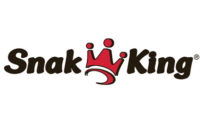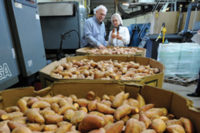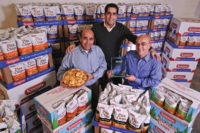Family-owned Ballreich Bros., Tiffin, Ohio, has a large fan base that pines for its various potato chips as well as crispy new shoestring potato sticks, popcorn, pretzels and other snacks. Recently, it entered the natural sweet potato chip category and just launched tasty potato sticks. Its quality, superior customer service and environmental/sustainability practices are a few of the other reasons we named Ballreich our 2014 Snack Manufacturer of the Year.
| Want more Ballreich Bros. information? |
| Want to see more images from Ballreich Bros.? Click here to see the full gallery! |
| SFWB visited the Ballreich Bros. in Tiffin, Ohio. Check out the video by clicking here! |
| Want to read more about Ballreich Bros.? Take a look at the SFWB plant feature by clicking here! |
Some snack products just seem to have a personality all their own. That’s the case with the potato chips and other snack products from Ballreich Bros. Inc. Its chips have an addictive, intense flavor, as well as superior quality, a wide variety of flavors and nostalgic, spirited packaging graphics. The company has an enthusiastic, customer-focused staff that not only respects the environment, but is fastidious at keeping the production facility clean. There’s also a happy family vibe from Ballreich’s owners—all of which, and more, prompted Snack Food & Wholesale Bakery to award Ballreich its 2014 Snack Food Manufacturer of the Year.
The Tiffin, Ohio-based potato chip maker has a true knack for giving its growing fan base the kind of products it wants. The chip flavors include Salt & Vinegar, Sour Cream & Onion, Bar-B-Q, Smokey Sweet Mesquite, No Salt Added and Cheddar & Sour Cream, to name a few.
“People just love our chips,” says a proud Brian Reis, president and CEO, and a third-generation family member. “People are very loyal to our brand. We’re very appreciative of the Snack Food Manufacturer of the Year award because we believe we’re the oldest snack food company still owned by the original family. So we’re very humbled and overwhelmingly proud for this outstanding recognition.”
Reis’ mother was a Ballreich, he points out, as we sample a few potato chip varieties, and he tells us how the company started out in Tiffin back in 1920. Fred Ballreich and his wife, Ethel, created a homemade potato chip operation in a dirt-floor garage. They used a copper kettle heated with wood scraps, waxed bags and loads of potatoes.
The couple called their potato chips “Marcelled,” which means “wavy,” a term adapted from a ladies’ wavy hairstyle popular in the 1920s. As the chips caught on, the Marcelled term stuck, and Fred was soon joined by his brother, Carl, to form a joint venture of Ballreich Brother’s Potato Chips. Between Fred’s sales expertise and baking skills and Carl’s strong work ethic and management skills, the company was well on its way to success.
Soon, the small waxed chip bags gave way to large metal tins and film bags and today to heat-sealed metallized polyester bags in sizes up to 16 oz. By the 1990, the company added many nonpotato-based snacks, such as party mix, pretzel sticks, rings and rods, pork rinds, tortilla chips, popcorn and other items, and now gives die-hard Ballreich’s chip fans a substantial 2-lb. bag-in-box.
In 2006, Reis (who is Carl’s grandson) and his wife, Linda, the company’s vice president, secretary and treasurer, became the sole owners of Ballreich’s after purchasing all of the outstanding shares of company stock from family shareholders. The next year, Haley Thomas—Brian and Linda Reis’ daughter—joined the family business as director of sales and vice president of marketing, and began the fourth generation of the Ballreich’s tradition.
Shortly thereafter, Reis’ son, Robert, came onboard as a full-time process manager, production manager and engineer after working part-time at the company for several years. Now there are baked, Flat (not Marcelled) Chips in the assorted flavors and No Salt potato chips, which are becoming more popular today for the lower sodium content. The products are packed in bags sized from 1 to 16 oz., and there are a host of items available in gift packs, 2-lb. boxes (which keep the chips from crushing), clubstore packs and multipacks.
Still family-operated after all of these years, Ballreich’s now has 67 employees. The company went from one truck route when Reis arrived to 17 company routes and 15 independent routes. “We could add three or four for Cleveland alone,” Reis notes.
The bustling 75,000-sq.-ft. production facility is situated right behind the original Ballreich home in what grew to be a residential neighborhood. “Most visitors are amazed that we’re sitting in the middle of a residential district,” Reis explains, “but we were here before anything else was, so that’s how we came to stay.”
Overall, Ballreich’s currently markets about 70 or so stock-keeping units (SKUs). The products are available under the company’s Ballreich’s brand and several private labels. The company produces about 35 of the SKUs in-house, having the nonpotato snacks contract-packaged.
The latest two products are Sweet Potato Chips, launched in September 2013, and Potato Sticks (shoestring potatoes), launched in late February, in Classic, Smokey Sweet Mesquite and Salt and Vinegar flavors. “We’re one of the few players in the Potato Sticks and Sweet Potato Chips arena, and the response to them has been great,” says Thomas. “The Sweet Potato Chips have no trans-fats, are low in saturated fat and sweet potatoes are good for you. We only use potatoes and sea salt and that’s it, so they have a clean label. That puts us in an all-natural niche, as they’re healthy and have no artificial colors or preservatives.”
Adds Reis: “We decided to start making the Potato Sticks because they taste great and the flavors are popular. We have a lot of Potato Sticks fans. Our customers and consumers across the country tell us they’re thrilled to get them.”
Ballreich’s products are available in most areas of Ohio and parts of the Mideast as well as Michigan, Indiana and parts of Wisconsin. They can also be ordered by phone and online at www.ballreich.com. “We mostly do direct-store-delivery (DSD) and also have some international and national contracts,” adds Thomas. “We sell to supermarkets, convenience stores, garden shops, hardware stores, clubstores, hotels and foodservice venues—practically anywhere chips are sold.”
Poised to grow
Reis left the Tiffin area at age 23 to work in other industries and returned to work at Ballreich’s 20 years later, when a family member asked him to come back. For decades, the chip company was a big fish in a small pond, Reis remembers. “When I came back, the business still hadn’t evolved much. It had no sales network or IT department, and very a small manufacturing layout in which to produce the chips. But I knew we could grow the business. All of the great regional players that used to be around here are gone or were bought up. Though we haven’t expanded much, we have remained very competitive and are still in business. Before returning, my wife, my daughter and I worked at big firms and gained a lot of experience that we can use to really boost Ballreich’s. We want to grow but must continue to make the best products.”
Reis says at this point, Ballreich’s is the youngest “old” company in the country. “We’re really good at DSD, so that’s what we focus on. And we’re going after the smaller volume customers, but more of them.”
Ballreich’s basically chose not to grow too much because it really didn’t have to. Throughout the years and even today, sales are extremely linear, Reis says. “Years ago, there was a potato chip company every 30 miles in this state,” he explains. “Ballreich’s was comfortable being small, but now that so many regional players are gone, we have few direct competitors. We’re fortunate that we’ve been able to stay here; we now have a footing to expand. In the last few years, we started ad campaigns to market the products more effectively. And we really listen to customers, so we’re good at working in what you might call the boutique potato chip trade.”
Fresh packaging
Reis and his “new team” gave the product packaging a refresh, updating the chip and snack bags with contemporary elements and brighter graphics. The large Ballreich logo that appears at the top of each package looks retro, and has been retained throughout the years to give the brand its familiar, nostalgic look. The metalized bags make the products look fresh and new.
“We create all of the packaging graphic updates in-house,” Thomas points out. “We recently revised our designs and then created new bag graphics for the new Sweet Potato and Potato Sticks products, and are in the midst of developing a large multibag variety pack. It’s a challenge to grab attention on store shelves, when the big players use seven-color graphics (we try to keep our costs lower) and have perhaps 60 feet of shelf space, where we get maybe four feet, for example.”
In addition to its loyal fans, another of the company’s assets is that it strives to be clever and innovative and likes to stir things up. “We will do what many bigger potato chips makers don’t want to do or won’t do,” Thomas says. “We’ll accommodate small customers, ship full truckloads to Mexico or make private-label products for small boutique stores. We can cater to a customer with as few as seven stores, even one store.”
The new family management group also got Ballreich’s more organized. “We upgraded the IT, quality control and accounting departments and also began talking with the big supermarkets and the big-box stores to see if we could enter those markets,” Reis adds. “That’s one way in which we began to improve the business, while at the same time, we don’t want to forget who we are. Now we’re trying to figure out if we can expand further, if it would be feasible to perhaps add another facility.”
Until recently, another reason why Ballreich’s has remained “a quiet, little potato chip company” is that since the economy took a tumble in 2008, cash flow hasn’t exactly been a gusher. “Funds just weren’t all that available in this area for a company like ours,” Reis admits. “It has been difficult to grow the business, and that’s frustrating, so we started talking with some banks outside of our area, and we’re hopeful that we can work with them. In the meantime, we continue to innovate, creating our products and packaging in-house. We have to be creative. And our staff is great. Many employees have been with us for the long haul—some 30 and 40 years. If you want something done, they will get it done, no matter what. Labor is hard to find, though, and that’s probably related to the tricky economy, to a degree.”
The single production line and multiple packaging lines produce all of the fried potato products. Ballreich’s sources the potatoes locally, when seasonally possible, from a farm less than 30 minutes from the plant. Off season, it purchases potatoes from several states, including Florida and the Carolinas.
Currently, it gets its sweet potatoes from North Carolina. “Last year, we conducted a test plot with a local farmer, and this year, we’ll conduct two more tests with various local farms,” Thomas explains. “We hope to source locally for the sweet potatoes, in addition to getting them from North Carolina.”
The production operation is also a true just-in-time manufacturer, Reis says, producing 2,000 lb. of product an hour and 5,000 during peak season. Incoming potatoes are inspected and processed the same day. “We go through everything [you see] here in about a week,” he points to all the stored ingredients and sweet potatoes being staged for processing.
Operating one eight-hour shift a day, four days a week (the fifth day is for maintenance and cleaning), the plant cooks the regular chips and shoestring Potato Sticks in soybean oil, while the Sweet Potato Chips are fried in cottonseed oil, which enhances their flavor, Reis says. “We still use the traditional partially hydrogenated oils with trans-fats,” he explains. “We are trying to figure out how to migrate zero trans-fat oils into our recipes to accommodate consumers and big-box retailers, and still have to find the right ones that will give us the right taste.”
Sustainability, food-safety updates
In terms of the environment, the chip company tries to “walk the walk” and reduces, reuses and recycles as much as possible to increase sustainability for paperboard, office paper, corrugated, packaging film, plastic and potato/food scraps. In fact, it recycles or repurposes 99% of the waste it generates, reusing its two-way corrugated shipping containers as many as 20 times. The food scraps go to local farmers for feed, while potato wash water replenishes farm fields. Packaging film is transformed into cushioning, gift wrap, table coverings and even crafts.
Of the total wastestream volume Ballreich does send to landfills, which is less than 1% of its waste, it collects that waste material weekly. “We also began changing out our warehouse lighting to reduce energy use,” says Robert Reis, production manager. “We recycle so much that we have eliminated a lot of our solid waste.”
How has Ballreich dealt with the revisions of the Food Safety Modernization Act (FSMA)? “Identically to any other chip company right now,” Reis explains. Currently certified at Level One of the Safe Quality Food (SQF) standards established through the Global Food Safety Initiative (GFSI), Ballreich’s expects to participate in a Level Two audit soon. “Our people are our most valuable asset, so we adhere to strict SQF standards. We try to be as clean as possible.”
Gift shop, other initiatives
In the future, the chip maker would like to try making its own tortilla chips. “It’s a similar process on the back end,” Reis says.
Thomas says the company will also pursue more private-label business. “We want to do this and not lose our DSD focus,” she adds. But there are several other projects, such as opening a company gift shop, that it will open to the public once it renovates the home behind the plant.
“We’re calling it called ‘Grannys’ Gift Shop (in Reis’ mother’s house),” Thomas says. “The shop will look like a general store, have lots of historic items and Ballreich and Ohio memorabilia. It will also have a lot of foods, in addition to what we make.”
Thomas says there are more projects than the company can possibly handle, but first it will gauge how well the Sweet Potato Chips and Potato Sticks sell. “Next, we might work on a big private-label project for a grocery distributor and would like to add more Potato Sticks flavors, if they’re successful










